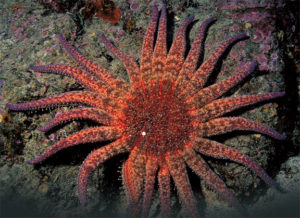 In California, as is the case with most of the worldwide diving community, the majority of us spend a lot more time admiring the beauty and antics of smaller creatures that inhabit our kelp forests, rocky reefs and sand flats. While those smaller wonders often leave us scratching our heads in sheer amazement during our dives, they don’t grab the headlines as often as larger animals like gray whales, sharks and dolphins do.
In California, as is the case with most of the worldwide diving community, the majority of us spend a lot more time admiring the beauty and antics of smaller creatures that inhabit our kelp forests, rocky reefs and sand flats. While those smaller wonders often leave us scratching our heads in sheer amazement during our dives, they don’t grab the headlines as often as larger animals like gray whales, sharks and dolphins do.
Sea stars provide classic examples of these smaller wonders. But in this issue sea stars do grab a headline. In this month’s CDN, Bonnie Cardone provides us with a wonderful overview of their natural history.
Unfortunately, all is not well in the world of sea stars. Things are out of balance. At least since June 2013, the populations of many species of sea stars along the west coast of North America have been decimated by an affliction known as sea star wasting syndrome. The broader syndrome describes a number of symptoms including rapidly growing skin lesions, tissue decay, fragmentation and death.
The syndrome was first seen in ochre stars in waters along the coast of Washington. Since then it has been documented from Alaska into Mexico, and it has serious implications on the populations of a number of species of sea stars as well as the overall health of our oceans.
There is some good news, and it is twofold: One, researchers believe they are coming closer to understanding what is causing the devastating “sea star associated densovirus” to ravage sea star populations and why it has spread so forcefully. In the years prior to 2013, the populations of many species of sea stars exploded, and the virus, one that has been present in west coast sea stars for decades, often spreads by physical contact. Expanding sea star populations meant it was more likely the virus would spread.
Two, the number of juvenile sea stars appears to be expanding in some areas. Scientists are hoping that the exploding population of juvenile sea stars in numerous species is a sign that these echinoderms have developed some natural resistance to the disease. At this stage, only time will tell, but this is what gives specialists the biggest reasons for hope at this time.
While sea stars might not grab the headlines, specialists do consider sunflower stars and ochre stars, species with populations that have been greatly reduced by the wasting syndrome, to be keystone species. This means that these species play especially large roles in the niches where they occur.
For now, it is a bit of a waiting game. As we wait, this scenario serves as a reminder of the delicate balance of our oceans, and the importance of every creature, large and small. Even the ones that don’t often grab the headlines are important to the overall health of the kelp forests, rocky reefs and sandy plains that we love to explore.









